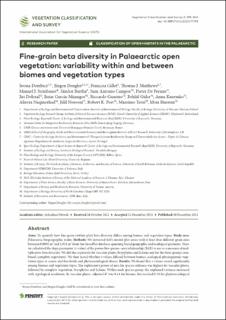Please use this identifier to cite or link to this item:
https://doi.org/10.21256/zhaw-23843| Publication type: | Article in scientific journal |
| Type of review: | Peer review (publication) |
| Title: | Fine-grain beta diversity in Palaearctic open vegetation : variability within and between biomes and vegetation types |
| Authors: | Dembicz, Iwona Dengler, Jürgen Gillet, François Matthews, Thomas J. Steinbauer, Manuel J. Bartha, Sándor Campos, Juan Antonio De Frenne, Pieter Dolezal, Jiri García-Mijangos, Itziar Guarino, Riccardo Güler, Behlül Kuzemko, Anna Naqinezhad, Alireza Noroozi, Jalil Peet, Robert K. Terzi, Massimo Biurrun, Idoia |
| et. al: | No |
| DOI: | 10.3897/VCS/2021/77193 10.21256/zhaw-23843 |
| Published in: | Vegetation Classification and Survey |
| Volume(Issue): | 2 |
| Page(s): | 293 |
| Pages to: | 304 |
| Issue Date: | 30-Dec-2021 |
| Publisher / Ed. Institution: | Pensoft |
| ISSN: | 2683-0671 |
| Language: | English |
| Subjects: | Biome; Bryophyte; Fine-grain beta diversity; GrassPlot; Lichen; Mean occupancy; Palaearctic grassland; Phytosociological class; Species–area relationship (SAR); Vascular plant; Vegetation type; Z-value |
| Subject (DDC): | 580: Plants (Botany) |
| Abstract: | Aims: To quantify how fine-grain (within-plot) beta diversity differs among biomes and vegetation types. Study area: Palaearctic biogeographic realm. Methods: We extracted 4,654 nested-plot series with at least four different grain sizes between 0.0001 m² and 1,024 m² from the GrassPlot database spanning broad geographic and ecological gradients. Next, we calculated the slope parameter (z-value) of the power-law species–area relationship (SAR) to use as a measure of multiplicative beta diversity. We did this separately for vascular plants, bryophytes and lichens and for the three groups combined (complete vegetation). We then tested whether z-values differed between biomes, ecological-physiognomic vegetation types at coarse and fine levels and phytosociological classes. Results: We found that z-values varied significantly among biomes and vegetation types. The explanatory power of area for species richness was highest for vascular plants, followed by complete vegetation, bryophytes and lichens. Within each species group, the explained variance increased with typological resolution. In vascular plants, adjusted R2 was 0.14 for biomes, but reached 0.50 for phytosociological classes. Among the biomes, mean z-values were particularly high in the Subtropics with winter rain (Mediterranean biome) and the Dry tropics and subtropics. Natural grasslands had higher z-values than secondary grasslands. Alpine and Mediterranean vegetation types had particularly high z-values whereas managed grasslands with benign soil and climate conditions and saline communities were characterised by particularly low z-values. Conclusions: In this study relating fine-grain beta diversity to typological units, we found distinct patterns. As we explain in a conceptual figure, these can be related to ultimate drivers, such as productivity, stress and disturbance, which can influence z-values via multiple pathways. The provided means, medians and quantiles of z-values for a wide range of typological entities provide benchmarks for local to continental studies, while calling for additional data from under-represented units. |
| URI: | https://digitalcollection.zhaw.ch/handle/11475/23843 |
| Fulltext version: | Published version |
| License (according to publishing contract): | CC BY 4.0: Attribution 4.0 International |
| Departement: | Life Sciences and Facility Management |
| Organisational Unit: | Institute of Natural Resource Sciences (IUNR) |
| Appears in collections: | Publikationen Life Sciences und Facility Management |
Files in This Item:
| File | Description | Size | Format | |
|---|---|---|---|---|
| 2021_Dembicz-etal_Fine-grain-beta-diversity-Palaearctic-open-vegetation.pdf | 2.86 MB | Adobe PDF |  View/Open |
Show full item record
Dembicz, I., Dengler, J., Gillet, F., Matthews, T. J., Steinbauer, M. J., Bartha, S., Campos, J. A., De Frenne, P., Dolezal, J., García-Mijangos, I., Guarino, R., Güler, B., Kuzemko, A., Naqinezhad, A., Noroozi, J., Peet, R. K., Terzi, M., & Biurrun, I. (2021). Fine-grain beta diversity in Palaearctic open vegetation : variability within and between biomes and vegetation types. Vegetation Classification and Survey, 2, 293–304. https://doi.org/10.3897/VCS/2021/77193
Dembicz, I. et al. (2021) ‘Fine-grain beta diversity in Palaearctic open vegetation : variability within and between biomes and vegetation types’, Vegetation Classification and Survey, 2, pp. 293–304. Available at: https://doi.org/10.3897/VCS/2021/77193.
I. Dembicz et al., “Fine-grain beta diversity in Palaearctic open vegetation : variability within and between biomes and vegetation types,” Vegetation Classification and Survey, vol. 2, pp. 293–304, Dec. 2021, doi: 10.3897/VCS/2021/77193.
DEMBICZ, Iwona, Jürgen DENGLER, François GILLET, Thomas J. MATTHEWS, Manuel J. STEINBAUER, Sándor BARTHA, Juan Antonio CAMPOS, Pieter DE FRENNE, Jiri DOLEZAL, Itziar GARCÍA-MIJANGOS, Riccardo GUARINO, Behlül GÜLER, Anna KUZEMKO, Alireza NAQINEZHAD, Jalil NOROOZI, Robert K. PEET, Massimo TERZI und Idoia BIURRUN, 2021. Fine-grain beta diversity in Palaearctic open vegetation : variability within and between biomes and vegetation types. Vegetation Classification and Survey. 30 Dezember 2021. Bd. 2, S. 293–304. DOI 10.3897/VCS/2021/77193
Dembicz, Iwona, Jürgen Dengler, François Gillet, Thomas J. Matthews, Manuel J. Steinbauer, Sándor Bartha, Juan Antonio Campos, et al. 2021. “Fine-Grain Beta Diversity in Palaearctic Open Vegetation : Variability within and between Biomes and Vegetation Types.” Vegetation Classification and Survey 2 (December): 293–304. https://doi.org/10.3897/VCS/2021/77193.
Dembicz, Iwona, et al. “Fine-Grain Beta Diversity in Palaearctic Open Vegetation : Variability within and between Biomes and Vegetation Types.” Vegetation Classification and Survey, vol. 2, Dec. 2021, pp. 293–304, https://doi.org/10.3897/VCS/2021/77193.
Items in DSpace are protected by copyright, with all rights reserved, unless otherwise indicated.